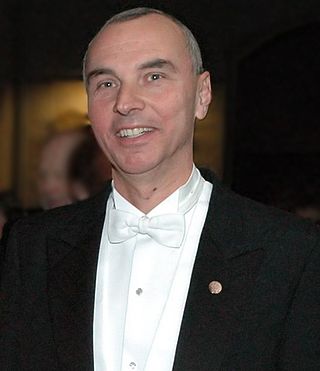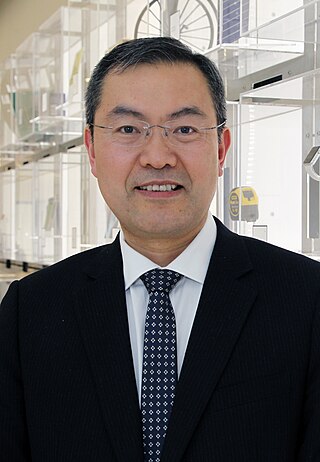Related Research Articles

Finite-difference time-domain (FDTD) or Yee's method is a numerical analysis technique used for modeling computational electrodynamics. Since it is a time-domain method, FDTD solutions can cover a wide frequency range with a single simulation run, and treat nonlinear material properties in a natural way.

Computational electromagnetics (CEM), computational electrodynamics or electromagnetic modeling is the process of modeling the interaction of electromagnetic fields with physical objects and the environment using computers.
Martin Allan Uman is an American engineer. He has been acknowledged by the American Geophysical Union as one of the world's leading authorities on lightning.

A lightning rod or lightning conductor is a metal rod mounted on a structure and intended to protect the structure from a lightning strike. If lightning hits the structure, it is most likely to strike the rod and be conducted to ground through a wire, rather than passing through the structure, where it could start a fire or cause electrocution. Lightning rods are also called finials, air terminals, or strike termination devices.
MIL-STD-461 is a United States Military Standard that describes how to test equipment for electromagnetic compatibility.

Levent Gürel is a Turkish scientist and electrical engineer. He was the director of Computational Electromagnetics Research Center (BiLCEM) and a professor in the Department of Electrical and Electronics Engineering at the Bilkent University, Turkey until November 2014. Currently, he is serving as an adjunct professor at the University of Illinois Urbana-Champaign, Department of Electrical and Computer Engineering. He is also serving as the founder and CEO of ABAKUS Computing Technologies.

Peter (Petre) Stoica is a researcher and educator in the field of signal processing and its applications to radar/sonar, communications and bio-medicine. He is a professor of Signals and Systems Modeling at Uppsala University in Sweden, and a Member of the Royal Swedish Academy of Engineering Sciences, the United States National Academy of Engineering (International Member), the Romanian Academy, the European Academy of Sciences, and the Royal Society of Sciences. He is also a Fellow of IEEE, EURASIP, IETI, and the Royal Statistical Society.
An electromagnetic pulse (EMP), also referred to as a transient electromagnetic disturbance (TED), is a brief burst of electromagnetic energy. The origin of an EMP can be natural or artificial, and can occur as an electromagnetic field, as an electric field, as a magnetic field, or as a conducted electric current. The electromagnetic interference caused by an EMP can disrupt communications and damage electronic equipment. An EMP such as a lightning strike can physically damage objects such as buildings and aircraft. The management of EMP effects is a branch of electromagnetic compatibility (EMC) engineering.

Chandima Gomes is a Sri Lankan engineer, physicist and writer who is now working as a distinguished professor of high-voltage engineering at the University of Witwatersrand, Johannesburg, South Africa. He is also a permanent resident of Malaysia. The platform of his research and engineering career is mainly Asia and Africa, where he works on lightning protection, grounding, and electromagnetic interference, on which topics he has put several of his research outputs into practice. Apart from lightning protection and electromagnetic compatibility that reduces economic losses from natural and man-made threats, he has also been working on human and animal safety against lightning mainly in developing countries in Asia and Africa. He is also an engineering consultant and trainer in lightning protection, grounding and bonding, electromagnetic interference and research methodology. He has conducted over 120 training programs all over the world.
Farhad Rachidi is an Iranian-Swiss scientist.
Marcos Rubinstein is a professor and chair at the University of Applied Sciences and Arts of Western Switzerland in Yverdon-les-Bains, Switzerland.
Richard Anthony Tell is a physicist at Richard Tell Associates, Inc. in Madison, Alabama. He was named a Fellow of the Institute of Electrical and Electronics Engineers (IEEE) in 2012 for his contributions to the assessment of, and safety standards for, human exposure to radio frequency energy.

The Smart Cities EMC Network for Training (SCENT) is a project funded by the European Union's Horizon 2020 research program under the Marie Skłodowska-Curie grant agreement No 812391. It is a Ph.D training network program in the field of Electromagnetic Compatibility (EMC) especially in the smart cities application. Three universities and twelve industries collaborate in SCENT project. Supported by the IEEE EMC Society Technical Committee 7: besides Ph.D training program, SCENT project also performs scientific training programs and social outreach programs.
Switching Control Techniques address electromagnetic interference (EMI) mitigation on power electronics (PE). The design of power electronics involves overcoming three key challenges:
- power losses
- EMI
- harmonics

Donald Nestor Heirman was an American electrical engineer and military officer.
Rodica Ramer is a Romanian born Australian professor of microelectronics at the University of New South Wales, where she and her team work on the development of radio-frequency microelectronic technologies, advancing wireless communication technology. She earned a Ph.D from the University of Bucharest in solid-state physics in 1992. Prior to working at UNSW, she was a senior research scientist at the Microwave Laboratory, National Centre for Nuclear Energy of Romania, a research associate at the Superconductivity Laboratory, the University of Alabama, Tuscaloosa, and at the Microwave Laboratory, Colorado State University, Fort Collins. She is a fellow of the Electromagnetics Academy.

ETUT is a research project funded by the European Commission's Horizon 2020 program under the Marie Sktodowska-Curie Actions Innovative Training Networks scheme. The project, undertaken by a collaborative effort of the University of Twente, the University of Nottingham, and Dnipro National University of Railway Transport, aims to develop efficient interfacing technology for more-electric transport amidst the ever-increasing demand in transportation systems which contribute to increased carbon dioxide emissions. The project has employed 12 Early Stage Researches who will work closely with six industrial partners to improve upon the existing electrical and energy storage systems that will help in alleviating the reliance on non-renewable energy sources for large-scale transportation systems such as railways and maritime transport. The project is segregated into two main groups with one focusing on power electronics for efficient use of energy resources in power delivery, and the other on electromagnetic compatibility of such systems.

Low-frequency electromagnetic compatibility is a specific field in the domain of electromagnetic compatibility (EMC) and power quality (PQ), which deals with electromagnetic interference phenomena in the frequency range between 2 kHz and 150 kHz. It is a special frequency range because it does not fit in the PQ problems, with range of up to 2 kHz, where relative levels of voltage and current can have massive impact on efficiency and integrity of electric systems, and neither in the conducted EMC range, which starts at 150 kHz and influences mainly informational systems, and already too far from radiated EMC range, which starts at 30 MHz and goes up to 1 GHz.

Yang Hao is an electrical engineer, academic, and author most known for his research in wireless connectivity and metamaterials. He is the holder of the QinetiQ/Royal Academy of Engineering (RAE) Research Chair, and serves as the Director of both the EPSRC Research Centre on Future Wireless Connectivity and the EPSRC Centre for Transformation Optics and Metamaterials. He is also a Professor of Antennas and Electromagnetics, and Deputy Vice Principal for Strategic Research at Queen Mary University of London (QMUL). He is a Co-Founder and Director of AOTOMAT, and co-founded a satellite communication company called Isotropic Systems.
References
- ↑ "vernon cooray". scholar.google.se. Retrieved 2022-04-26.
- 1 2 "Vernon Cooray - Uppsala University, Sweden". katalog.uu.se.
- 1 2 About the Authors - An Introduction to Lightning. Springer. 2015. ISBN 9789401789370.
- ↑ "Cooray, Vernon". Uppsala University Publications.
- ↑ "Vernon Cooray - Uppsala University, Uppsala - UU - ResearchGate". ResearchGate.
- ↑ "ICLP Centre - Committees". www.iclp-centre.org.
- ↑ "ICLP Centre - about". www.iclp-centre.org.
- ↑ "Blixtmaster Vernon Cooray upplyser Institutet" (in Swedish). Retrieved 2018-02-04.
- ↑ "Högsäsong för blixt och dunder" (in Swedish). Retrieved 2018-02-04.
- ↑ "Många myter om blixt och dunder" (in Swedish). Retrieved 2018-02-04.
- ↑ "Trots att risken är liten – Sex av tio svenskar är åskrädda" (in Swedish). Retrieved 2018-02-04.
- ↑ "The Lightning Flash, 2nd Edition - The IET". www.theiet.org.
- ↑ "Lightning Protection - The IET". www.theiet.org.
- ↑ "Lightning Electromagnetics - The IET". www.theiet.org.
- ↑ An Introduction to Lightning - Vernon Cooray - Springer. Springer. 2015. ISBN 9789401789370.
- ↑ "Blixt och åska. Så fungerar naturens fyrverkeri". www.hvi.uu.se.
- ↑ Cooray, Vernon (2003). "On the concepts used in return stroke models applied in engineering practice". IEEE Transactions on Electromagnetic Compatibility. 45 (1): 101–108. doi:10.1109/TEMC.2002.808041.
- ↑ Cooray, Vernon (2009). "A Novel Procedure to Represent Lightning Return Strokes Current Dissipation Return Stroke Models". IEEE Transactions on Electromagnetic Compatibility. 51 (3): 748–755. doi:10.1109/TEMC.2009.2019764. S2CID 11545695.
- ↑ Cooray, Vernon (1994). "Calculating lightning-induced overvoltages in power lines. A comparison of two coupling models". IEEE Transactions on Electromagnetic Compatibility. 36 (3): 179–182. doi:10.1109/15.305462.
- ↑ Cooray, Vernon; Rahman, Mahbubur; Rakov, Vladimir (2009). "On the NOx production by laboratory electrical discharges and lightning". Journal of Atmospheric and Solar-Terrestrial Physics. 71 (17–18): 1877–1889. Bibcode:2009JASTP..71.1877C. doi:10.1016/j.jastp.2009.07.009.
- ↑ Cooray, Vernon (2002). "Some considerations on the "Cooray-Rubinstein" formulation used in deriving the horizontal electric field of lightning return strokes over finitely conducting ground". IEEE Transactions on Electromagnetic Compatibility. 44 (4): 560–566. doi:10.1109/TEMC.2002.804774.
- ↑ Becerra, Marley; Cooray, Vernon (2006). "A self-consistent upward leader propagation model". Journal of Physics D: Applied Physics. 39 (16): 3708–3715. Bibcode:2006JPhD...39.3708B. doi:10.1088/0022-3727/39/16/028.
- ↑ Cooray, Vernon; Cooray, Gerald (2017). "On the Action of the Radiation Field Generated by a Traveling-Wave Element and Its Connection to the Time Energy Uncertainty Principle, Elementary Charge and the Fine Structure Constant". Atmosphere. 8 (3). MDPI: 46. Bibcode:2017Atmos...8...46C. doi: 10.3390/atmos8030046 .
- ↑ Cooray, Vernon; Cooray, Gerald (2016). "On the Momentum Transported by the Radiation Field of a Long Transient Dipole and Time Energy Uncertainty Principle". Atmosphere. 7 (11). MDPI: 151. Bibcode:2016Atmos...7..151C. doi: 10.3390/atmos7110151 .
- ↑ "Lightning researcher awarded Honorary Doctorate in Sri Lanka - Uppsala University, Sweden". www.uu.se.
- ↑ Sabath, F. (2017). "EMC personality profile". IEEE Electromagnetic Compatibility Magazine. 6 (2): 38–40. doi:10.1109/MEMC.0.7989989.
- ↑ "Vernon Cooray wins 2012 Karl Berger Award - Uppsala University, Sweden". www.uu.se.
- ↑ "2015 ASLI Choice Awards Winners". 21 January 2016.